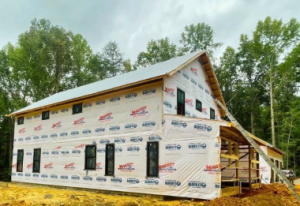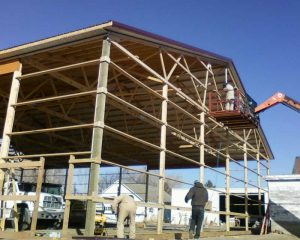Let’s start with a definition of Design Pressure. According to AAMA (American Architectural Manufacturers Association), WDMA (Window and Door Manufacturers Association), and NAFS (North American Fenestration Standard), Design Pressure (DP) is a rating identifying loads induced by wind and/or static snow a product is rated to withstand in its end-use application. So basically, DP is a performance specification for how strong a window is, expressed in how many pounds per square foot (psf) of pressure a window can withstand. This specification can fluctuate based on several factors, such as geographic location, building height, window location on a building, etc. All of these factors are used to calculate what Design Pressure (DP) needs to be for a specific window or door.
 During testing, a window or door is attached to a wooden frame and clamped to a specially designed wall. Air pressure is gradually reduced on window inside, increasing outside pressure until window fails (breaks beyond repair). Test pressure must reach 1.5 times the design pressure for 10 seconds without window suffering permanent damage. In other words, a window with a DP of 30 would have to withstand 45 psf. The instant window fails, psf is recorded and is used for calculation. Laboratories will then issue labels indicating DP for this specific window or door – labels used by Window and Door Manufacturers Association (WDMA), American Architectural Manufacturers Association (AAMA) and other organizations.
During testing, a window or door is attached to a wooden frame and clamped to a specially designed wall. Air pressure is gradually reduced on window inside, increasing outside pressure until window fails (breaks beyond repair). Test pressure must reach 1.5 times the design pressure for 10 seconds without window suffering permanent damage. In other words, a window with a DP of 30 would have to withstand 45 psf. The instant window fails, psf is recorded and is used for calculation. Laboratories will then issue labels indicating DP for this specific window or door – labels used by Window and Door Manufacturers Association (WDMA), American Architectural Manufacturers Association (AAMA) and other organizations.
Design Pressure you need for windows in your barndominium, shouse (shop/house) or post frame home will vary. For example, in Florida, DP required for a window can range anywhere from DP 35 (if you are in state’s center) to DP 60 (if you are located along the coast). Your local building department can assist you in determining what DP rating is needed, based on location and building design. Most municipalities have maps or easy-to-read charts clearly explaining proper Design Pressure requirements needing to be met in order to effectively protect your home. You can then verify windows you are considering meet required DP ratings by checking window stickers and matching it to engineering window drawings.
 Prescriptive codes are codes that PRESCRIBE exactly what size/grade/shape components to use at various locations and how to connect them. Prescriptive codes are very limited in their overall applicability. Prescriptive codes “get by with” using simple, uniformly-distributed loads (e.g., a balanced snow load) to determine component size. Structural engineers are seldom required when prescriptive codes are in play (and that’s one of the main reasons they exist).
Prescriptive codes are codes that PRESCRIBE exactly what size/grade/shape components to use at various locations and how to connect them. Prescriptive codes are very limited in their overall applicability. Prescriptive codes “get by with” using simple, uniformly-distributed loads (e.g., a balanced snow load) to determine component size. Structural engineers are seldom required when prescriptive codes are in play (and that’s one of the main reasons they exist).





